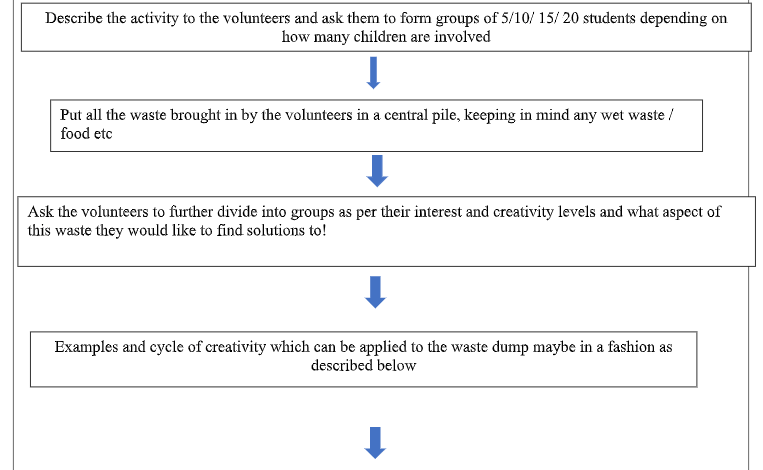1. Title : I choose…… to Reuse….. Do U?
2. Type: Group
3. Materials needed: Participants will be encouraged to think creatively and bring the things
from their own personal closet, home, kitchen, book cabinet or from their personal stuff
which according to them is waste. This could include the following, for example:
- Worn out / torn dresses/ clothes/ t shirts / jeans / school uniform
- Old shoes/ school bags/ backpacks/ purses (some with broken handles /clips etc)
- Hair accessories/ costume jewellery with broken beads/ clasps etc
- Kitchen waste : (dry or wet ) could be cardboard boxes/ bottles / used cartons/ empty
- grocery bags/ paper -plastic bags, steel ware , old knives, kitchen utensils/ cooking
- wares etc
- Old-worn out/ used books – notebooks, half used stationary, half broken pencils, not
- working -dried up pens, painting colours, used glue stick etc
- Things we would give our local scrap dealer ( useless tins/ non-functional machines,
- kitchen mixer or similar appliances
- Broken pots from the garden,
- Used bathroom , bath care empty shampoo / soap bottles etc
There is no limit of quantity but we encourage everyone to bring no more than 5 pieces from
any category.
4. Learning Outcome / Objective:
The primary purpose of this activity is to enable each one to understand the basics of reuse/
recycle / reduce waste issues. In general people/ families are unaware of the vastness of this
problem beyond their homes, or even within their homes.
Each person should be able to understand the waste generated per person and how it adds up
even for a small group like this.
Secondary objective for the group would be to understand how to recycle or reuse this
collected waste so that very little or ‘NO’ waste should be transported into the landfills. The
group would be encouraged to sort out this collected stuff in such a manner that, they could
either find takers for these things or are able to engage themselves creatively for recycling or
reusing the things.
The total time taken by this activity is expected to be at least 2 hours. The group is expected
to outline their planning and route that they propose to take. They have to physically
segregate these things for reuse (identifying how, where and by whom it would be reused).
They have to create real life solutions and list them out for each and every piece of item in
the pile.
6. Method: Provide a stepwise method to carry out the activity.


7. Briefing and debriefing advice:
Reuse of clothes, jewellery, accessories, bags, shoes, books or any other item at home or
workplace (in this case school premises) is the primary responsibility of each citizen of this
planet. Each of us has to understand the role we play as an individual and as a community.
Individual acceptance and understanding has to be a norm in our society. Reuse should not be
looked down upon as a symbol of miserliness or downgraded to the status of low income
groups. It should be revered and looked upon as a quality of character and care for this planet
and its humanity.
It’s the youth of today who can change the mindset of our communities, nations and the
world at large.
Social media should be used to look for the right fit for ‘things which need a home for reuse’.
This experiment is an initiative for bringing together groups school children who are the
future of the planet tomorrow. They will know where to take us !!
This activity is an attempt to let them take the matter in their hands and see how they can
solve this problem starting from the grass root level.
